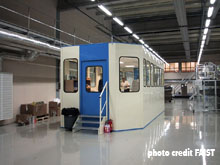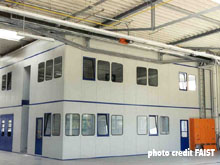Which performance in terms of sound insulation for a cabin ?
The performance in terms of sound insulation of a cabin - construction specially designed to protect people (e.g. machine operators) from ambient noise, consisting of a fully enveloping structure - is very frequency dependent and is primarily related on the one hand to the performance of acoustic insulation panels (characterized by their sound reduction index) and also where appropriate to that of the silencer (for ventilation) and also to the number and to dimensions of cuts and openings, and on the other hand to the sealing imperfections and to structure born (bridging) sound transmissions.

the acoustical performance of a cabin depends on the weakest construction element |
|
|
This performance can be expressed in terms of difference (with and without the cabin) of overall A-weighted sound pressure levels or of sound pressure levels in octave bands at specified locations (such as maximum value at 1 m from the walls of the cabin, average value inside the cabin, value at a workplace) - also known as acoustic pressure reduction -.
For orders of magnitude (and with respect to a noise spectrum like "pink noise"), a level difference of up to 10 dBA can usually be obtained without special requirements, while a level difference from 10 to 20 dBA requires a standard cabin without important leakage, while a level difference of 20 to 30 dBA requires a standard cabin with sealing joints carefully implemented, a soundprrofing floor and a resilient mounting (cabin with a vibration control system), and while a difference of 30 to 40 dB involves high performance booths carefully designed and installed (a level difference even higher shall involve a special construction).
The prediction of acoustic performance (for airborne sound) of a cabin e.g. vertical walls - including doors, portholes and windows -, floor, roof can be performed with the simulation software SILDIS® (double or even triple depending on the number of layers assimilable to plates - steel, aluminum, gypsum, wood, glass - separated by porous media e.g. mineral or polyester wool but also: air). Overall performance is often impacted by the weakest element; the quality of design, construction and execution of assemblies is a key success factor.
Verification of acoustic performance of a cabin can be conducted in accordance with ISO 11957 Acoustics - Determination of sound insulation performance of cabins - Laboratory and in situ measurements
Which metallic sound insulation panels for a cabin (for soundproofing or soundproofed) ?
With regard to metallic sound insulation panels (also called soundproofing panels) used for current applications in industrial soundproofing such as building a cabin - construction specially designed to protect people (e.g. machine operators) from ambient noise, consisting of a fully enveloping structure -, they generally consist of an outer casing (usually made of non-stainless steel, most of the time: with paint) and of an absorbing filling (quite often: mineral wool) covered by a surfacing (mostly: a fiber glass) and also a perforated protection (mostly: galvanized steel). For the outer casing, a powder coating usually provides the best possible protection against corrosion: classification up to C5 according to ISO 12944.
In some cases, the envelope of acoustic insulation panels of cabins can be made of stainless steel (SS 304, SS 316) or aluminum.
As required, the absorbing filling may consist of acoustic foam or polyester wool and, for some applications, be protected by a waterproof surfacing (polyurethane film and for extreme cases: painting).
In order to increase the sound reduction index in a given frequency range, an intermediate plate (usually made of steel) and an additional spacing absorbent layer may be inserted into the acoustic insulation panels, the performance of such insulation panels being based on the double shell effect.
For specific cases, a damping material (viscoelastic) can be incorporated.
Acoustic performance of sound insulation panels for cabins (in terms of sound reduction index) is very frequency dependent, being related mainly (besides the quality of the joint between panels basing their airtightness ):
- for panels with simple shell effect: mainly to the total mass density
- for panels with double shell effect: mainly to the mass density of each of the facings and to their spacing (the mass density of the inner absorbing lining may also be accounted if significant)
The prediction of acoustic performance of the partitions of a cabin can be performed with the simulation software SILDIS®®.
The verification of acoustic performance of the partitions of a cabin can be conducted in accordance with ISO 140-3 Acoustics - Measurement of sound insulation in buildings and of building elements - Part 3: Laboratory measurements of airborne sound insulation of building elements
What are the input data useful for sizing the partitions of a cabin (soundproofed or for soundproofing) ?
The input data useful for sizing the partitions of a cabin - construction specially designed to protect people (e.g. machine operators) from ambient noise, consisting of a fully enveloping structure - are mainly the level of acoustic performance required by frequency (insertion loss, residual sound pressure level).
Where appropriate, the existence of additional constraints should be accouned e.g. the possibility of disassembly, the transportability, the reaction to fire, the need for the partitions to provide thermal insulation, or to be translucent to allow the vision etc ...
Whether control and monitoring cabins, or fixed booths for operators or even cabins mounted on vehicles are concerned, the sizing of the partitions must account the needs in terms of sound reduction (this is to the ability to oppose the transmission of noise), the effects of amplification of sound levels related to the existence of the cabin itself - specific constraints related to the acoustic comfort (speech intelligibility) and to the livability (visual aspect) inside may necessitate the use of particular absorbing linings, for walls, for ceiling or even for the floor - and also the needs in terms of accessibility whose effectiveness depends on the airtightness (rotating doors, sliding doors) and also the needs for air circulation (ventilation), the needs in terms of cuts for ancilliaries (cables, ducts, pipes ...).
These various input data are necessary for the selection of products and construction systems appropriate to the acoustic performance required for the partitions of a cabin depending on the acoustic performance and on the respective area of its various subsets: acoustic insulation panels for facades, roof and floor where necessary, access, glass frames, silencers, cuts and openings.
In general, two designs are possible for the walls of soundproof cabins, with regard to the visible face - i.e. inside the soundproofing cabin - of the opaque vertical panels, which can be:
- perforated (often, it is a metal sheet protecting a layer of linear wool or polyester): they then combine the functionality of sound reduction (i.e. the limitation of sound transmission) with a complementary functionality of sound absorption to avoid unwanted sound reflections; typically such panels can offer, at high frequencies, an attenuation index greater than 35 dB and an acoustic absorption coefficient close to 100%
- non-perforated: they then only have a sound reduction function (i.e. the limitation of sound transmission), the reduction of the reverberation of the noise must then imperatively be achieved by the implementation of a suspended acoustic ceiling

soundprroofed workshop office |

soundproofed workshop office |
|
The intended use of the cabin also counts, depending on whether it comes to:
- limiting the noise exposure of operators: aiming for a noise level of 80 dB(A) in certain extremely noisy environments, with marked low-frequency components (e.g. in a steelworks) is a challenge
- allowing activities inside the cabin requiring sustained concentration: lower sound levels must then be offered to the occupants, requiring superior acoustic performance for the walls
Of course, the number of occupants of a soundproof cabin is decisive for its design, impacting all at once:
- its dimensions
- its equipment e.g. electrical plugs, air renewal rate, heating power
In case of constructions located outdoor, resistance to wether and to corrosion must also be taken into account, what may affect the definition of appropriate construction systems.
Other parameters may be involved such as the authorized mass, the required longevity or the available budget.
But the acoustic performance, impacting the sizing of the walls (and sometimes involving the need for a floor with anti-vibration decoupling for a "box within a box" design, and even, in some case: double walls) is of course a fundamental aspect of the selection of a soundproofing cabin: ITS offers a wide choice.
Spread the word !
Why choose an absorbent or an acoustic complex based on polyester wool rather than any other sound absorbing material ?
Such a choice is appropriate in all cases where it is searched for a product showing a very good absorption factor and environmentally friendly (because recyclable and without grinding) and whose application (in ordinary situations) generally does not require any surfacing. Such a filling can be used for the improvement of the performance of an existing enclosure (sounproofing hood) / of an existing (acoustic) partition.
Why implement a lining inside a metallic casing, a metallic screen, a partition or an enclosure made of plasterboard or with wood sidings with a material being damping and sound absorbing (acoustic complex) to improve their acoustic performance?
A material being damping and absorbent (acoustic complex) can increase the sound reduction index and the sound insulation of a plate on which it is applied by combining in a single product requiring only a single application complementary properties damping (of the damping) and of absorption (of the absorbent).
More Articles
- Why implement a lining inside a metallic casing, a metallic screen, a partition or an enclosure made of plasterboard or with wood sidings with a sound-absorbing material to improve their acoustic performance?
- Why implement a lining of a metallic casing, of a metallic duct, a pipe, of a plasterboard partition, of a partition with wood sidings with a damping material to improve their acoustic performance?
- Which ventilation for an enclosure (acoustic hood)?
- Which performance in terms of sound insulation for an enclosure (soundproofing hood) ?
Page 7 of 12